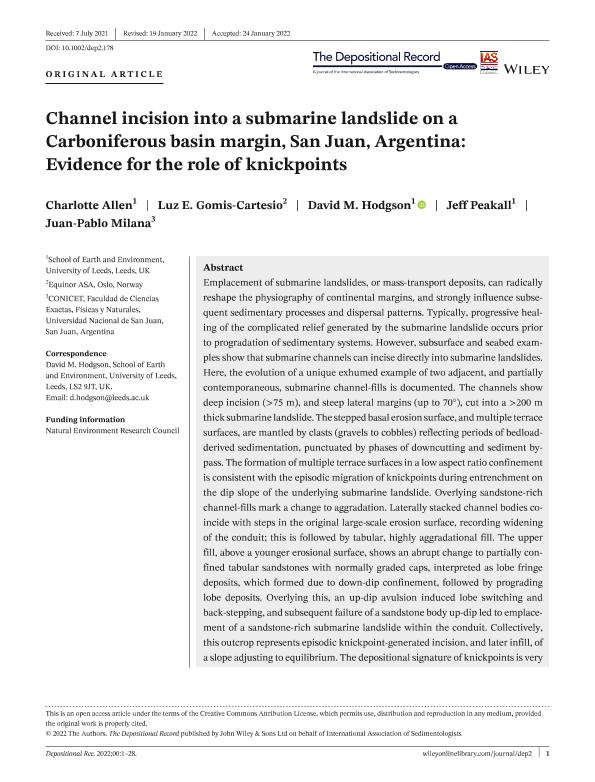Mostrar el registro sencillo del ítem
dc.contributor.author
Allen, Charlotte
dc.contributor.author
Gomis Cartesio, Luz E.
dc.contributor.author
Hodgson, David M.
dc.contributor.author
Peakall, Jeff
dc.contributor.author
Milana, Juan Pablo

dc.date.available
2023-01-04T12:31:52Z
dc.date.issued
2021-06
dc.identifier.citation
Allen, Charlotte; Gomis Cartesio, Luz E.; Hodgson, David M.; Peakall, Jeff; Milana, Juan Pablo; Channel incision into a submarine landslide on a Carboniferous basin margin, San Juan, Argentina: Evidence for the role of knickpoints; John Wiley & Sons; Depositional Record; 8; 2; 6-2021; 628-655
dc.identifier.issn
2055-4877
dc.identifier.uri
http://hdl.handle.net/11336/183259
dc.description.abstract
Emplacement of submarine landslides, or mass-transport deposits, can radically reshape the physiography of continental margins, and strongly influence subsequent sedimentary processes and dispersal patterns. Typically, progressive healing of the complicated relief generated by the submarine landslide occurs prior to progradation of sedimentary systems. However, subsurface and seabed examples show that submarine channels can incise directly into submarine landslides. Here, the evolution of a unique exhumed example of two adjacent, and partially contemporaneous, submarine channel-fills is documented. The channels show deep incision (>75 m), and steep lateral margins (up to 70°), cut into a >200 m thick submarine landslide. The stepped basal erosion surface, and multiple terrace surfaces, are mantled by clasts (gravels to cobbles) reflecting periods of bedload-derived sedimentation, punctuated by phases of downcutting and sediment bypass. The formation of multiple terrace surfaces in a low aspect ratio confinement is consistent with the episodic migration of knickpoints during entrenchment on the dip slope of the underlying submarine landslide. Overlying sandstone-rich channel-fills mark a change to aggradation. Laterally stacked channel bodies coincide with steps in the original large-scale erosion surface, recording widening of the conduit; this is followed by tabular, highly aggradational fill. The upper fill, above a younger erosional surface, shows an abrupt change to partially confined tabular sandstones with normally graded caps, interpreted as lobe fringe deposits, which formed due to down-dip confinement, followed by prograding lobe deposits. Overlying this, an up-dip avulsion induced lobe switching and back-stepping, and subsequent failure of a sandstone body up-dip led to emplacement of a sandstone-rich submarine landslide within the conduit. Collectively, this outcrop represents episodic knickpoint-generated incision, and later infill, of a slope adjusting to equilibrium. The depositional signature of knickpoints is very different from existing models, but is probably reflective of other highly erosional settings undergoing large-scale slope adjustment.
dc.format
application/pdf
dc.language.iso
eng
dc.publisher
John Wiley & Sons

dc.rights
info:eu-repo/semantics/openAccess
dc.rights.uri
https://creativecommons.org/licenses/by/2.5/ar/
dc.subject
KNICKPOINTS
dc.subject
LOBES
dc.subject
MASS-TRANSPORT DEPOSIT
dc.subject
SUBMARINE CHANNEL
dc.subject
SUBMARINE LANDSLIDES
dc.subject
TERRACE DEPOSITS
dc.subject.classification
Geociencias multidisciplinaria

dc.subject.classification
Ciencias de la Tierra y relacionadas con el Medio Ambiente

dc.subject.classification
CIENCIAS NATURALES Y EXACTAS

dc.title
Channel incision into a submarine landslide on a Carboniferous basin margin, San Juan, Argentina: Evidence for the role of knickpoints
dc.type
info:eu-repo/semantics/article
dc.type
info:ar-repo/semantics/artículo
dc.type
info:eu-repo/semantics/publishedVersion
dc.date.updated
2022-09-20T19:20:41Z
dc.journal.volume
8
dc.journal.number
2
dc.journal.pagination
628-655
dc.journal.pais
Reino Unido

dc.description.fil
Fil: Allen, Charlotte. University of Leeds; Reino Unido
dc.description.fil
Fil: Gomis Cartesio, Luz E.. No especifíca;
dc.description.fil
Fil: Hodgson, David M.. University of Leeds; Reino Unido
dc.description.fil
Fil: Peakall, Jeff. University of Leeds; Reino Unido
dc.description.fil
Fil: Milana, Juan Pablo. Consejo Nacional de Investigaciones Científicas y Técnicas. Centro Científico Tecnológico Conicet - San Juan. Centro de Investigaciones de la Geosfera y Biosfera. Universidad Nacional de San Juan. Facultad de Ciencias Exactas Físicas y Naturales. Centro de Investigaciones de la Geosfera y Biosfera; Argentina
dc.journal.title
Depositional Record
dc.relation.alternativeid
info:eu-repo/semantics/altIdentifier/doi/http://dx.doi.org/10.1002/dep2.178
Archivos asociados
